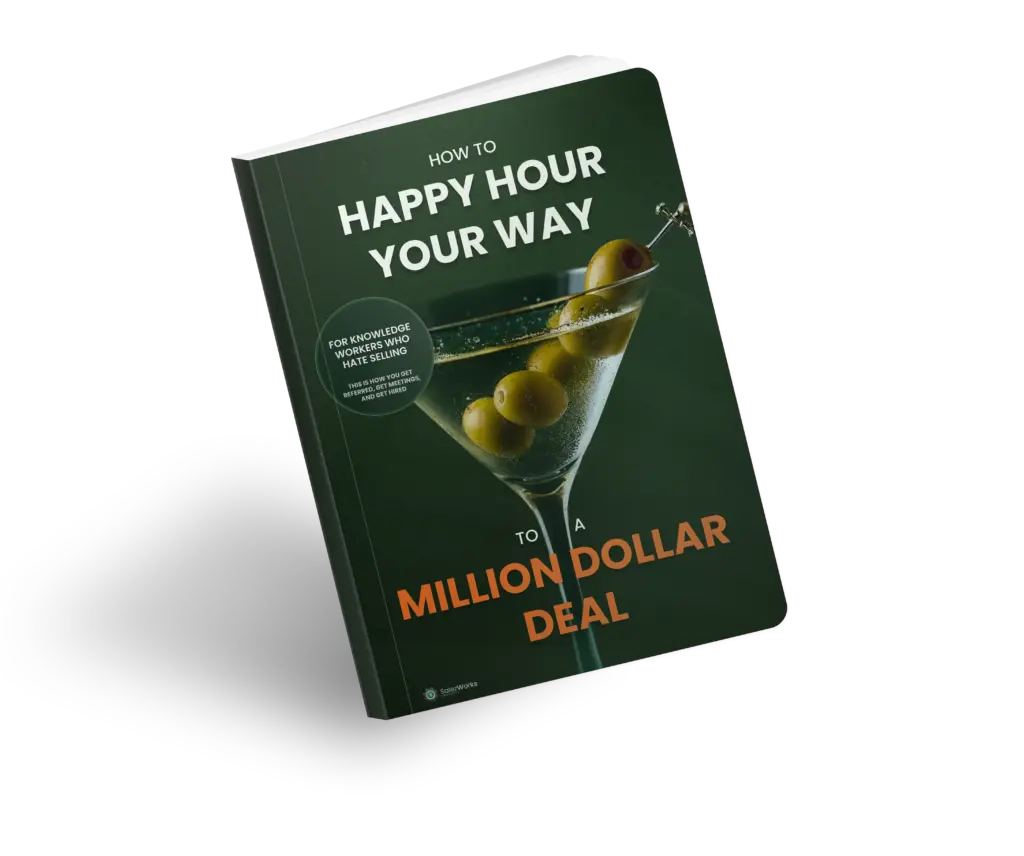Why Your Best Partnership Could Be Your Biggest Risk
Sarah’s financial planning practice was thriving. For three years running, she’d hit her revenue targets, largely thanks to one phenomenal referral relationship with a local real estate agent who sent her 2-3 high-quality clients every month. Life was good—until it wasn’t.
When her top referral partner decided to retire and move to Florida, Sarah’s business didn’t just slow down—it practically stopped. Overnight, she lost 70% of her new client pipeline. What had seemed like her greatest business asset had actually been her most dangerous vulnerability.
Sarah had fallen into the referral concentration trap, and she’s not alone.
The Hidden Danger in Your Best Relationship
Here’s the uncomfortable truth: any time one relationship represents more than 30% of your revenue, you’re not running a business—you’re playing Russian roulette with your livelihood.
The referral concentration trap is seductive because it feels so good when it’s working. That one amazing partner who “gets” your value proposition, consistently sends quality referrals, and makes growing your business feel effortless. It’s natural to lean into what’s working and invest more energy in your most productive relationships.
But concentration creates fragility. And in business, fragility kills.
The Five Concentration Catastrophes
Understanding how concentration risk materializes can help you recognize the warning signs before it’s too late.
1. The Retirement Bomb
The Scenario: Your top referral source retires, relocates, or changes careers without warning.
Real-World Impact: A commercial insurance broker lost 60% of his new business when his primary referral partner—a commercial real estate agent—suddenly decided to focus exclusively on residential properties.
The Warning Sign: You find yourself saying, “I don’t know what I’d do without [Partner Name].”
2. The Relationship Rupture
The Scenario: A misunderstanding, competitive conflict, or personal disagreement damages your key referral relationship.
Real-World Impact: An employment attorney saw her practice crater when a falling out with an HR consulting firm (over a client situation) ended a relationship that had been generating 50% of her new cases.
The Warning Sign: Your business success is dependent on maintaining one person’s goodwill.
3. The Market Shift Squeeze
The Scenario: Economic changes, industry disruption, or regulatory shifts affect your primary referral partner’s business, cascading to yours.
Real-World Impact: When COVID hit, a business consultant who relied heavily on referrals from event planners watched his pipeline evaporate as the events industry shut down.
The Warning Sign: Your referral sources are all vulnerable to the same market forces.
4. The Competition Capture
The Scenario: A competitor offers your key referral partner better terms, exclusive arrangements, or stronger incentives.
Real-World Impact: A wealth management firm lost their biggest referral source when a larger competitor offered the referring CPA firm a formal partnership agreement they couldn’t match.
The Warning Sign: You have informal relationships where competitors could formalize better deals.
5. The Internal Upheaval
The Scenario: Changes within your referral partner’s organization affect your contact person or their referral priorities.
Real-World Impact: A marketing consultant’s main revenue stream disappeared when their primary contact at a large accounting firm was promoted and their replacement had existing relationships with other vendors.
The Warning Sign: Your relationship exists with individuals rather than institutional processes.
Measuring Your Concentration Risk
Most business owners underestimate their concentration exposure because they haven’t measured it properly. Here’s how to assess your current risk level:
The 30/50/70 Rule
Calculate what percentage of your new business comes from:
- Your top referral source (should be under 30%)
- Your top 3 referral sources combined (should be under 50%)
- Your top 5 referral sources combined (should be under 70%)
If you exceed these thresholds, you’re in the danger zone.
The Quarterly Dependency Check
Every quarter, ask yourself:
- If my top referral source stopped referring tomorrow, how long could I sustain my current revenue?
- What percentage of my pipeline would disappear if my best referring relationship ended?
- How many months would it take to replace the revenue from my top referral source?
If the answers make you uncomfortable, you have a concentration problem.
The Stress Test Question
The ultimate concentration risk assessment is simple: “Could I maintain 80% of my current revenue if any single referral relationship ended tomorrow?”
If the answer is no, you’re over-concentrated and operating in a high-risk state.
The Concentration Fix: From Dangerous to Diversified
Recognizing concentration risk is the first step. Fixing it requires systematic action.
Step 1: Stop Feeding the Concentration
Immediate Action: If one relationship represents more than 40% of your new business, stop investing additional time and energy in deepening that single relationship until you’ve built alternatives.
This doesn’t mean neglecting your best referral source—it means redirecting your growth energy toward building other relationships while maintaining your current top performer.
Step 2: Strategic Gap Analysis and Targeted Recruitment
Goal: Identify the most valuable referral gap in your current network, then systematically recruit the ideal partner to fill it.
Strategy: Quality over quantity. Use client intelligence to identify strategic opportunities, then leverage satisfied clients to access high-potential referral partners.
The Process:
- Week 1-2: Strategic Client Interview Phase: Interview your best clients using two critical questions: “What advisors or circumstances led you to seek my services?” (upstream partners) and “What new opportunities or needs has our work together created for you?” (downstream partners). Look for the intended consequences of your work—what naturally happens next in your clients’ journey.
- Week 3-4: Journey Mapping and Gap Analysis: Map the complete client journey to identify upstream referral sources (who sends clients to you) and downstream opportunities (who should clients work with after you). Focus on partners where slight service overlap creates cohesive client experiences and immediate revenue potential.
- Week 5-6: Partner Targeting: Research and identify the top 2-3 providers in your priority gap category who serve clients similar to your ideal profile. Bonus if they are already providing services to your shared clients.
- Week 7-12: Warm Introduction and Cultivation: Use your satisfied mutual clients to facilitate introductions, then invest significant time in building one high-quality strategic partnership.
Step 3: Industry and Channel Diversification
The Problem: Many businesses have concentration risk not just in individual relationships but in relationship types. All their referrals come from the same industry or through the same channels.
The Solution: Deliberately seek referral sources from:
- Different industries than your current top sources
- Expanded professional levels (if you focus on executives, add mid-level professionals)
- New geographic areas or markets
- Alternative referral mechanisms (formal vs. informal, digital vs. personal)
Step 4: The Reciprocity Multiplier
The Insight: The fastest way to build new referral relationships is through reciprocity—actively referring business to potential partners before asking for referrals back.
The Method: For each new potential referral partner, commit to sending them at least one qualified referral within 30 days of your initial meeting.
This approach dramatically accelerates relationship building and creates natural obligation for reciprocity.
Step 5: Formalize Your Top Relationships
The Risk Reducer: Formal agreements, even simple ones, create more stability and predictability than purely informal relationships.
Options Include:
- Written referral agreements outlining mutual expectations
- Regular business reviews to discuss referral performance and goals
- Exclusive territory or service agreements (where appropriate)
- Joint marketing initiatives that create shared investment in the relationship
Building Anti-Fragile Referral Systems
The goal isn’t just to reduce concentration risk—it’s to build referral systems that actually get stronger when individual relationships end or change.
The Network Effect Principle
Instead of building linear relationships (you → partner → referrals), create network effects where your referral sources know and refer to each other. This creates:
- Redundancy: Multiple pathways to the same opportunities
- Multiplication: Referral sources generating referrals for each other
- Resilience: The network continues functioning even if you lose individual nodes
The Systematic Approach
Monthly Quota System: Set a minimum target for new referral conversations each month (suggest 3-5 new potential partners).
Quarterly Rebalancing: Every quarter, measure your concentration levels and actively work to reduce over-dependence on any single source.
Annual Partner Audit: Once per year, formally review all referral relationships for health, reciprocity, and strategic alignment.
The Concentration Wake-Up Call
Concentration risk in referral partnerships isn’t just about diversification—it’s about building a sustainable business that can thrive regardless of what happens to any individual relationship.
The businesses that survive and thrive long-term are those that recognize concentration risk early and take systematic action to address it. They understand that their best referral relationship might also be their biggest vulnerability.
The question isn’t whether you’ll eventually lose your top referral source—people retire, companies change, relationships evolve. The question is whether you’ll be prepared when it happens.
Don’t wait for the wake-up call. Start measuring your concentration risk today, and begin building the diversified referral foundation that will protect and grow your business for years to come.
Ready to eliminate your concentration risk and build a resilient referral system?
Grab my ebook “How to Happy Hour your Way to a Million Dollar Deal” for just $1 and get FREE access to “The Referral Edge” training, where you’ll learn how to systematically identify concentration vulnerabilities, develop multiple referral streams, and create anti-fragile referral systems that actually get stronger over time. Get it HERE
This training includes the exact frameworks and tools you need to assess your current risk level and build the diversified referral network that will protect your business from any single relationship failure.







